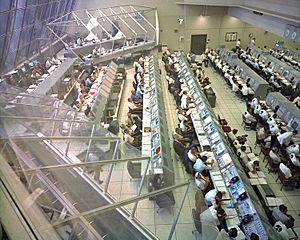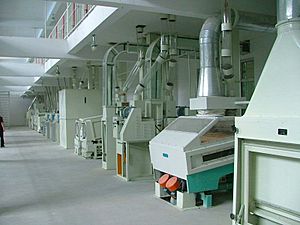Engineer facts for kids
Engineer is a person with a proper education in the field of engineering. The word engineer is derived from the Latin root ingenium, meaning "cleverness". Engineers design materials, structures, machines and systems while considering the limitations imposed by practicality, safety and cost. Much of the work is applied science, using information given by scientists to do their work. Apart from working with things, an engineer must also be good at working with people and money.
Contents
Roles and expertise
Design
Engineers develop new technological solutions. During the engineering design process, the responsibilities of the engineer may include defining problems, conducting and narrowing research, analyzing criteria, finding and analyzing solutions, and making decisions. Much of an engineer's time is spent on researching, locating, applying, and transferring information. Indeed, research suggests engineers spend 56% of their time engaged in various information behaviours, including 14% actively searching for information.
Engineers must weigh different design choices on their merits and choose the solution that best matches the requirements. Their crucial and unique task is to identify, understand, and interpret the constraints on a design in order to produce a successful result.
Specialization and management
Most engineers specialize in one or more engineering disciplines. Numerous specialties are recognized by professional societies, and each of the major branches of engineering has numerous subdivisions. Civil engineering, for example, includes structural and transportation engineering and materials engineering include ceramic, metallurgical, and polymer engineering. Mechanical engineering cuts across just about every discipline since its core essence is applied physics. Engineers also may specialize in one industry, such as motor vehicles, or in one type of technology, such as turbines or semiconductor materials.
Several recent studies have investigated how engineers spend their time; that is, the work tasks they perform and how their time is distributed among these. Research suggests that there are several key themes present in engineers’ work: (1) technical work (i.e., the application of science to product development); (2) social work (i.e., interactive communication between people); (3) computer-based work; (4) information behaviours. Amongst other more detailed findings, a recent work sampling study found that engineers spend 62.92% of their time engaged in technical work, 40.37% in social work, and 49.66% in computer-based work. Furthermore, there was considerable overlap between these different types of work, with engineers spending 24.96% of their time engaged in technical and social work, 37.97% in technical and non-social, 15.42% in non-technical and social, and 21.66% in non-technical and non-social.
Engineering is also an information-intensive field, with research finding that engineers spend 55.8% of their time engaged in various different information behaviours, including 14.2% actively seeking information from other people (7.8%) and information repositories such as documents and databases (6.4%).
The time engineers spend engaged in such activities is also reflected in the competencies required in engineering roles. In addition to engineers’ core technical competence, research has also demonstrated the critical nature of their personal attributes, project management skills, and cognitive abilities to success in the role.
Types of engineers
- Aerospace engineers design space vehicles or airplanes.
- Biomedical engineers design and work with medical equipment.
- Chemical engineers use chemicals to make products like drugs and medicines or fertilizers for crops.
- Civil engineers work on roads, bridges, buildings and other public structures.
- Computer engineers design and build computers and the parts that computers are made of.
- Electrical engineers work with electricity and design electrical equipment, from small things like radios and computers to large things like the wires that carry electricity across the country.
- Electronic engineers work with electronics, which are used to build computer parts and electrical equipment.
- Environmental engineers design and implement solutions to remediate and restore the environment.
- Manufacturing engineers design and improve the machines and assembly lines that make things. They work with robots, hydraulics and air-operated devices to help companies work faster and better with fewer mistakes.
- Mechanical engineers design machines or things that move, like cars and trains. A mechanical engineer also might help design electricity generating stations, oil refineries, and factories.
- Mechatronics engineers build robots and things that are like robots, but not exactly. They do things that are robotic-like.
- Nanotechnology engineers study very small things, like strings of atoms and how they are put together.
- Nuclear engineers design and build nuclear plants. They also study the characteristic behaviors of certain radioactive or unstable elements.
- Structural engineers are dealing with design and analysis of buildings and large non-building structures to withstand both the gravity and wind loads as well as natural disasters.
- Software engineers design and write programs for computers.
- Systems engineers look at how complicated things work and try to make them faster and smarter. They look at the big picture.
Many engineering projects engineers do are large and very complicated. Often different kinds of engineers work together and help each other. As an example, computer engineers need help from electrical engineers to build a computer. The computer needs programs written by software engineers. The computer could be used by aerospace engineers to control an airplane. An airplane is a big mechanical system with many parts, so a mechanical engineer and a systems engineer are also needed.
Related pages
Images for kids
-
The Challenger disaster is held as a case study of engineering ethics.
See also
 In Spanish: Ingeniero para niños
In Spanish: Ingeniero para niños





